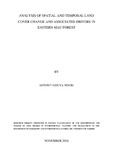| dc.description.abstract | Land cover changes in any ecosystem vary in space and time in terms of effects on ecosystem services. The spatial-temporal analysis of land cover changes in Eastern Mau Forest of Kenya was carried out to address the problems of types of land cover changes; nature of drivers of land cover changes and; resource use sustainability. The objectives of addressing the above problems were to determine the types and amount of spatial-temporal land cover changes; the drivers of land cover changes and; sustainable ways of using forest resources. The hypotheses used to guide in achieving the study objectives were that no significant land cover changes had occurred; there were no unique drivers behind land cover changes and; that forest resources use was sustainable in Eastern Mau Forest.
The data used in this study included Landsat imageries, topographic maps, forest boundaries, ground control points, sub-location and county boundaries, rivers shapefile, settlement shapefile, population data and forest resource use data. The data files were required in spatial-temporal analysis of forest cover change using geo-spatial and geo-statistical analysis techniques. The geo-spatial analysis techniques used were digital image classification, classification overlay and land cover change detection while the geo-statistical analysis techniques were area geometry computation, error matrix computation, temporal and spatial autocorrelation.
The results of data analysis showed that there were seven land cover classes in Eastern Mau Forest including indigenous forest, cropland, grassland, plantation forest, shrubland, built-up area and bare ground. In the 1986-2014 period plantation forest changed by 19,007.91 hectares, grassland by 7,227.54 hectares, indigenous forest by 6,052.32 hectares, shrubland by 3,008.79 hectares, cultivated fields by 57.96 hectares, built up area by 11.97 hectares and bare ground by 5.94 hectares. The study concluded that there was more land cover change on the eastern side of the area of study than on the western side; that indigenous and plantation forests were the most likely land cover types to disappear; that cropland and built up area expansions were the main drivers of land cover change; and that sustainable use of forest resources would only be possible if expansion in cropland was checked or reduced. The study therefore recommended that resettlement activities be reduced or eliminated in the Eastern Mau Forest area. Excision of forest land for crop cultivation should not be encouraged. Lastly, scientific research should be carried out on sustainable plantation forest activities and favourable exotic tree species as a measure against unchecked cropland expansion. | en_US |



